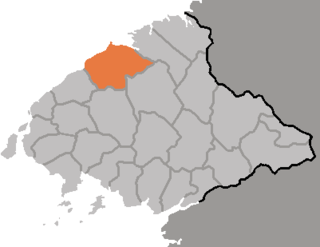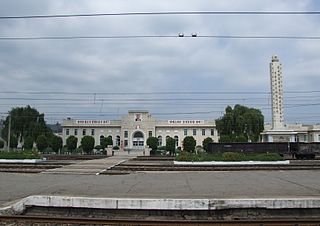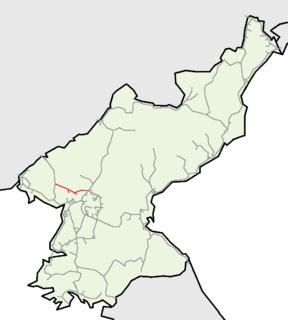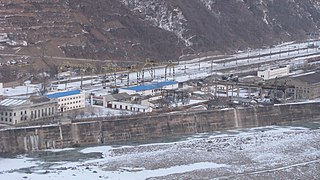
The Yalu River, also called the Amrok River or Amnok River, is a river on the border between North Korea and China. Together with the Tumen River to its east, and a small portion of Paektu Mountain, the Yalu forms the border between North Korea and China and is notable as a site involved in military conflicts such as the First Sino-Japanese War, the Russo-Japanese War, World War II, and the Korean War.

Sinŭiju ; Sinŭiju-si, known before 1925 in English as Yeng Byen City) is a city in North Korea which faces Dandong, China across the international border of the Yalu River. It is the capital of North P'yŏngan province. Part of the city is included in the Sinŭiju Special Administrative Region, which was established in 2002 to experiment with introducing a market economy.

Wiwŏn County is a kun, or county, in northern Chagang province, North Korea. It stands across the Yalu River from the People's Republic of China. It was originally part of North P'yŏngan province, but was annexed to Chagang in 1954. It borders Manp'o and Sijungto the north, Kanggye and Songgan to the east, Ch'onch'ŏn to the southeast, Kop'ung to the south and west, and Ch'osan to the west.

Sakchu County is a kun, or county, in northern part of North P'yŏngan province, in North Korea. It lies along the Yalu River bordering the People's Republic of China to the north. Within North Korea, it borders Ch'angsŏng to the east, Ch'ŏnma and Taegwan to the south, and Ŭiju to the west.

Chŏngju Ch'ŏngnyŏn Station is a railway station in Yŏkchŏn-dong, Chŏngju city, North P'yŏngan Province, North Korea. It is the junction of the P'yŏngŭi and P'yŏngbuk lines of the Korean State Railway.

The Sŏhae Line, also known as the Anju Colliery Line, is a partially electrified standard-gauge secondary line of the Korean State Railway in South P'yŏngan Province, North Korea, running from Mundŏk on the P'yŏngŭi Line to Hwap'ung. The line is electrified between Mundŏk and P'yŏngnam Sŏho and between Ch'ŏngnam and Sŏsi.

The P'yŏngbuk Line is an electrified standard-gauge secondary trunk line of the Korean State Railway in North Pyŏngan Province, North Korea, running from Chŏngju on the P'yŏngŭi Line to Ch'ŏngsu; it meets the Ch'ŏngnyŏn P'arwŏn Line at Kusŏng, and at Ch'ŏngsu, via a bridge across the Yalu River, it goes to Shanghekou, China, where it connects to China Railway's Fengshang Railway to Fenghuangcheng.

The Paech'ŏn Line is a partially electrified standard-gauge secondary railway line of the Korean State Railway in South Hwanghae Province, North Korea, running from Changbang on the Hwanghae Ch'ŏngnyŏn Line to Ŭnbit.

The Ch'ŏngnyŏn P'arwŏn Line is a non-electrified standard-gauge secondary railway line of the Korean State Railway in North P'yŏngan Province, North Korea, running from Kujang on the Manp'o and P'yŏngdŏk Lines to Kusŏng on the P'yŏngbuk Line.
The Pyeongbuk Railway was a privately owned railway company in Japanese-occupied Korea.

Ch'ŏngsu Station is a railway station of the Korean State Railway in Ch'ŏngsu Workers' District, Sakchu County, North P'yŏngan Province, North Korea. It is the northern terminus of the P'yŏngbuk Line of the Korean State Railway. The line continues past the station to a factory at Namsal-li.
Pup'ung Station is a railway station of the Korean State Railway in Pup'ung, Sakchu County, North P'yŏngan Province, North Korea, on P'yŏngbuk Line of the Korean State Railway. It is also the starting point of the Sup'ung Line and the Amrokkang Line.

Sup'ung Station is a railway station of the Korean State Railway in Sup'ung Workers' District, Sakchu County, North P'yŏngan Province, North Korea; it is the terminus of the Sup'ung Line of the Korean State Railway.
Amrokkang Station is a freight-only railway station of the Korean State Railway in Hoan, Sup'ung Workers' District, Sakchu County, North P'yŏngan Province, North Korea; it is the terminus of the Amrokkang Line of the Korean State Railway.
Kusŏng Station is a railway station of the Korean State Railway in Yŏkchŏn-dong, Kusŏng city, North P'yŏngan Province, North Korea, on the P'yŏngbuk Line of the Korean State Railway. It is also the western terminus of the Ch'ŏngnyŏn P'arwŏn Line.
The Taegwalli Line is a non-electrified railway line of the Korean State Railway in Taegwan County, North P'yŏngan Province, North Korea, running from Sinon on the P'yŏngbuk Line to Taegwalli Station, a private station for Korean Workers Party officials.

The Sup'ung Line is an electrified railway line of the Korean State Railway in North P'yŏngan Province, North Korea, running from Pup'ung on the P'yŏngbuk Line to Sup'ung.

The Unbong Line is a secondary railway line of the Korean State Railway located entirely within Unbong-rodongjagu, Chasŏng County, Chagang, North Korea, running from Sangp'unggang on the Pukpu Line to Kuunbong.

Kuunbong Station is a freight-only railway station in Unbong-rodongjagu, Chasŏng County, Chagang Province, North Korea; adjacent to the Chasŏng Dam on the Yalu River, it is the terminus of the Unbong Line of the Korean State Railway.
The Yangsi Line was a non-electrified standard-gauge railway line of the Korean State Railway in North P'yŏngan Province, North Korea, running from Namsi (Yŏmju) on the P'yŏngŭi Line to South Sinŭiju, likewise on the P'yŏngŭi Line, with which it was merged in 1964.

















